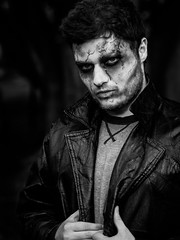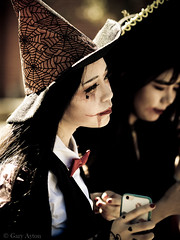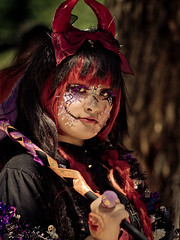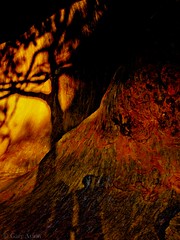Portraits in the harsh sun can be very trying ordeal for the photographer with a lot of issues to overcome.
One of the main issues is getting shallow depth of field so your subject will be the focus while the background is blurred.
Let’s assume we will be using an Olympus E510 with Olympus ZD 50mm f/2.0 macro lens (but almost any camera with wide open lens will do).
The main problem is the flash x-sync shutter speed.
Using the Sunny 16 rule, in bright sunlight at ISO 100 and 1/180th sec shutter, your aperture will be about f/11 – not great for portraits – we want somewhere near f/2.0-3.5 to make the subject stand out, so let’s see what we can do.
If you have a camera and flash that will do Super FP flash (Olympus FL-50 for instance) or High Speed Sync (HSS) on Canon or Nikon then you can bump up your shutter speed until the exposure for sunlit ambient light gives a nice wide open aperture, then you just have to hope your flash output will be sufficient for the subject distance and the loss of output due to the special focal plane flash mode (typically, the flash output halves for every 2 stops shutter speed up from the x-sync speed).
See here for my post on using Super FP or HSS flash for this purpose.
But what if you can’t afford a Super FP or HSS flash, or you wish to use your flash off camera and these modes won’t be possible?
Most Olympus dSLRs have a flash sync of 1/180th sec, and even at ISO 100, you will need a ND8 filter to get to a reasonably wide aperture of about f/4.5 – not really enough for our shallow depth of field.
But there is a little trick to get around this problem although you still need your ND8 filter.
If you use a non-dedicated flash, or use non-TTL hotshoe adapter, you can use manual exposure mode on most cameras to go to faster shutter speeds than the default x-sync speed (BUT not with the Panasonic GH-1 unfortunately – you are stuck at 1/160th sec!).
Depending on your camera and whether or not you use radio wireless triggers, you can use faster shutter speeds and only get a small band at the bottom of your frame which does not get light from the flash. This is not a problem if that part of the image is distant background.
Using this trick, you can use flash fill-in very easily at more than 2m from your subject at ISO 100, f/2.2, 1/400th sec even with a low powered flash such as the Olympus Ring Flash (just remember to alter its manual output to desired fill effect).
Let’s see what effect different shutter speeds has when using the Olympus E510 and a wired flash (ie. mechanical PC sync via cable or non-TTL hotshoe adapter or non-dedicated flash such as Canon 580EX II in an E510 hotshoe):
Please ignore differences in exposures and just look at the extent of the black band at the bottom of the image.
First, at 1/250th second – practically perfect!

At 1/320th sec, the band becomes obvious but very manageable for nearly all shots:

At 1/400th sec, the band is now very prominent, but should still allow many shots to be composed without this affecting the subject:

At 1/500th sec, essentially unusable apart from special circumstances where subject is less than half of the frame:

Although this works on most cameras, it is especially useful for Four Thirds cameras as the 4:3 image aspect ratio allows more width for portraits and thus you can more afford to not have part of your image lit by the flash.
With Canon, Nikon, Sony, or Pentax cameras with their 3:2 image aspect ratio, not only do you have the problem that in portrait orientation there is wasted pixels at the top or bottom or your image, but with this trick, you are even more limited in composing your subject as you also lose ability to use all of your already narrow width.
4:3 aspect ratio is to me, the best ratio for portaits in portrait orientation, and this little trick can further improve your portraits – have fun!
Unfortunately, using cheap radio trigger devices generally gives more of a band at the same shutter speed, so depending on your composition, you may need to reduce the shutter speed by a half to a third of a stop when compared with direct PC sync – see here.
If you have a pro Canon dSLR such as the 1D MarkIII, the flash sync is 1/300th second (with EX speedlights only) and you can purchase the very expensive new Pocket Wizard FlexTT5 radio triggers which have a hypersync function allowing full flash output at 1/500th sec without banding – see Rob Galbraith’s tests using a Canon 1DMIII. The 1DMIII also allows ISO 50 (albeit at reduced image quality) and thus even wider apertures or less of a ND filter – perhaps a polariser instead.
Please Panasonic, in your next firmware update, allow a switch which will allow users to use faster shutter speeds than 1/160th on the GH-1 for the above purpose at least!
More information and tips on outdoor portraiture here.










